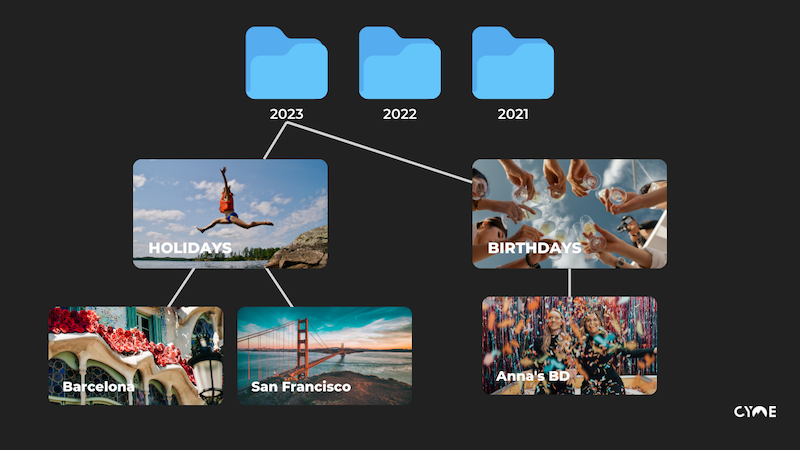In the digital age, managing and organizing our vast collections of photos has become increasingly important. Apple Photos provides a robust platform for organizing, preserving, and reliving our cherished memories. In this article, we will explore the key principles of effective photo organization in Apple Photos, covering both general strategies and specific tips for professional photographers. From utilizing iCloud and Time Machine for secure backups to creating folders, albums, and smart albums for streamlined organization, we’ll provide you with the knowledge and tools to master photo organization.
Additionally, as we delve into the advanced features of Apple Photos that can greatly enhance the workflow of professional photographers, it’s important to consider exploring this kind of complementary companion tools as they offer specialized functionalities designed to meet the unique needs of photographers. By integrating these tools, you can unlock additional creative options, expand your editing capabilities, and optimize your overall workflow. They provide valuable resources to elevate your photography skills and achieve outstanding results.
So let’s embark on this journey towards photo organization mastery and unlock the full potential of Apple Photos.
Table of contents
How to organize photos in Apple Photos
To embark on our journey towards photo organization mastery, let’s lay the foundation by exploring the key principles of organizing your photos effectively in Apple Photos. By following these organizational strategies, you can establish a solid structure for your photo library, making it a breeze to locate specific moments and events.
Main Backup and Organization for Your Images in Apple Photos
Safeguard Your Photos with iCloud and Time Machine
To ensure the safety of your valuable memories, it is highly recommended to use iCloud to store your photo library. By enabling iCloud Photo Library, your photos will be securely stored in the cloud, accessible across all your Apple devices, and protected against loss or device damage. This ensures your photos are always backed up and available whenever and wherever you need them in full resolution.
Saving images in full resolution is essential for photographers to maintain the quality and integrity of their work. It preserves every detail, color, and nuance, enabling stunning and professional-looking images. Full-resolution images offer greater flexibility for editing, printing, and showcasing, allowing photographers to present their vision with clarity and precision. It’s a vital practice that empowers photographers to deliver exceptional results.
While iCloud offers convenient cloud storage and seamless synchronization across Apple devices, it’s understandable that some may find the subscription plans costly or keep your photos on a private server to protect the confidentiality of your data. In such cases, you can explore other backup solutions to safeguard your photo library.
One option is to utilize external hard drives or portable storage devices. These devices provide ample storage capacity at a one-time cost, allowing you to manually transfer and backup your photos from Apple Photos. Simply export your desired photos or entire library to the external storage device regularly to maintain a secure backup.
Another option is to leverage third-party cloud storage providers that offer free or more affordable plans. Companies like Google, Microsoft, and Dropbox provide storage solutions that can be integrated with Apple Photos. You can choose a plan that fits your storage needs and budget, and then configure Apple Photos to sync with the chosen cloud storage provider. This way, you can still benefit from the convenience of cloud backup while having more flexibility in terms of cost.
In addition to iCloud, consider using Time Machine—a backup feature available on macOS—to create regular backups of your entire photo library. Time Machine ensures that even if any unforeseen data loss occurs, you can easily restore your entire photo collection.
Create Folders and Albums for Efficient Organization
When it comes to organizing your photos in Apple Photos, the use of folders and albums is a powerful strategy. Folders act as high-level containers, allowing you to create a hierarchical structure for your photo library. This structure helps you categorize and group related albums together, providing a streamlined organization system.
For example, let’s say you have a folder named “Vacation”. Within this folder, you can create separate albums for different trips you have taken, such as “Barcelona”, “San Francisco”, “Tokyo”, and so on. This way, you can keep all the photos from each specific trip neatly organized in their respective albums within the “Vacation” folder.
By creating folders and albums, you can easily navigate through your photo library and locate specific sets of photos without sifting through your entire collection. It also provides a visually appealing and intuitive way to organize your memories.
In addition to this kind of organization, you can also create folders and albums to sort your photos by year. For example, you can have folders named “2020”, “2021”, “2022”, and so on.
Within each yearly folder, you can further organize your photos into albums based on specific events, themes, or trips that occurred during that year. For instance, within the “2023” folder, you can create albums like “Family Reunion”, “Summer Vacation”, or “Graduation.”
By organizing your photos in this way, you’ll have a clear overview of your collection and can easily navigate through different years to locate specific photos or events. It also helps maintain a sense of chronological order, allowing you to track your memories as they unfold over time. You can still utilize folders and albums for further categorization within each year. For instance, within the “Summer Vacation” album in the “2023” folder, you can create sub-albums for different destinations, such as “Hawaii”, “Europe Trip”, or “Road Trip”. This nested structure allows you to drill down into specific events while maintaining the overall organization by year.
By incorporating the use of folders, albums, and yearly organization, you create a comprehensive system that combines chronological order and thematic categorization. This ensures that your photo library remains tidy, easily accessible, and provides a cohesive narrative of your life’s moments throughout the years.
Remember, flexibility is key, and you can adapt this organizational structure to fit your personal preferences and needs. The goal is to establish a system that simplifies the management of your photos and makes it effortless to find and relive your cherished memories.

Useful Tips: Utilize Artificial Intelligence and External Tools for Enhanced Organization
Apple Photos employs powerful AI algorithms to analyze and understand the content of your photos, allowing you to search for specific objects, scenes, or even people. This AI-driven feature helps you quickly locate photos based on their visual elements.
However, for those seeking an even more advanced and comprehensive search experience, Peakto offers an alternative solution. Powered by cutting-edge AI technology, Peakto goes beyond basic image recognition and provides a metacataloging capability for your entire photo library. By analyzing the visual characteristics, context, and metadata of your photos, Peakto can categorize them based on specific criteria such as nature, food, people, architecture, and more. This external tool enhances the search capabilities of Apple Photos, enabling you to find the photos you desire with enhanced precision and efficiency. Whether you’re a professional photographer or an avid enthusiast, Peakto offers an additional layer of AI-driven organization to help you better manage and explore your vast collection of memories.
How to further organize your photos in Apple Photos
Utilize Keywords and Tags
To further enhance the organization of your photo library, take advantage of keywords and tags in Apple Photos. You can assign keywords to your photos, such as “beach,” “family,” or “birthday,” to quickly locate specific images later. Simply select the desired photos, click on the “Info” button, and add relevant keywords in the appropriate field.
To utilize keywords and tags effectively in Apple Photos, follow these steps to enhance the organization of your photo library:
- Open Apple Photos on your device and navigate to the desired photo or set of photos that you want to assign keywords and tags to.
- Select the photos by clicking on them. You can choose multiple photos at once by holding down the Command (⌘) key while selecting.
- Once the photos are selected, click on the “Info” button, which looks like a lowercase “i” inside a circle. You can find this button in the toolbar at the top of the Photos app window.
- In the Info panel that appears, you’ll see various fields where you can enter metadata for the selected photos. Look for the field labeled “Keywords” and click on it.
- Type in relevant keywords that describe the content or theme of the selected photos. For example, if the photos are from a beach vacation, you can enter keywords like “beach,” “sun,” “sand,” etc. Separate multiple keywords with commas.
After assigning keywords, you can also add tags to specific individuals, objects, or locations within the photos. On the same “Info” menu, scroll down to the “People & Places” section in the Info panel and click on the “Add a Tag” button:
- Enter the desired tag, such as a person’s name, a pet’s name, or a specific landmark. Apple Photos will try to recognize faces in the photos and suggest tags based on its facial recognition capabilities.
- Repeat the process for each photo or set of photos that you want to organize with keywords and tags.
Useful Tips: Utilize Facial Recognition for Easy Identification
Apple Photos incorporates advanced facial recognition technology, allowing you to identify and categorize individuals in your photos. By using the People feature, you can assign names to recognized faces, making it convenient to find photos of specific people. The app will automatically group photos of the same person together, saving you time and effort in organizing your collection.

What can I do with all my digital photos thanks to Apple Photos?
Rediscover Memories with Intelligent Search
Apple Photos incorporates the Memories feature, automatically curating collections of your photos and videos based on specific dates, locations, or people. Memories can serve as a delightful way to rediscover past moments and relive cherished experiences. The app intelligently creates albums with matching themes, music, and transitions, providing a nostalgic journey through your photo library.
Moreover, Apple Photos boasts a powerful search function that allows you to find photos using various parameters. You can search by date, location, keywords, people, or even objects within images. This intelligent search capability enables you to locate specific photos swiftly, even within vast collections.
Useful Tips: Collaborate and Share Memories With Shared Albums
Shared albums in Apple Photos provide a collaborative and interactive platform for sharing your precious memories with friends and family. With shared albums, you can create an album and invite others to contribute their photos, creating a collective collection of shared moments.
Once you’ve created a shared album, you can invite others via their Apple ID or share a link to join the album. Contributors can then add their own photos, comment on existing photos, and engage in conversations within the album. This collaborative aspect allows multiple perspectives and memories to be captured and shared, creating a rich and comprehensive experience.
Shared albums in Apple Photos are designed to facilitate collaboration and sharing of photos but only among individuals using Apple devices and having an iCloud account. They provide an ideal platform for events like weddings, vacations, or family gatherings, where multiple participants can contribute their photos, creating a collective collection of shared moments. It’s a great way to bring everyone together and relive those special moments from different perspectives, provided they are using an iPhone or have access to iCloud.
Furthermore, shared albums offer various options for customization, including allowing contributors to add, view, and edit photos, or limiting their access to only viewing the album. This flexibility ensures that you can control the level of collaboration and privacy within the shared album.
Essential Tips for Professional Photographers
For professional photographers, Apple Photos offers a range of features designed to optimize workflow, enhance editing capabilities, and maximize the potential of your camera equipment. In this section, we will explore essential tips that will empower you to take full advantage of Apple Photos as a professional photographer.
From harnessing the power of RAW files to simplifying the importing process, these tips will elevate your photo management experience and help you achieve stunning results. Let’s dive in and discover how Apple Photos can revolutionize your professional photography workflow.
Embrace the Power of RAW Files
In the world of photography, RAW files are highly regarded for their unparalleled image quality and flexibility in post-processing. Apple Photos recognizes the importance of RAW files and provides excellent support for them. When you capture photos in RAW format with your camera devices, you preserve the maximum amount of data, including details in shadows and highlights, allowing for greater creative control during editing.
One of the key advantages of RAW files is their expanded dynamic range. They can capture a wider range of tones and colors, resulting in more vibrant and lifelike images. Additionally, RAW files offer better color accuracy, ensuring that the hues in your photos are reproduced with precision.
By importing RAW files into Apple Photos, you unlock the full potential of your camera’s capabilities. The app provides robust tools and editing options specifically designed to work with RAW files, allowing you to fine-tune every aspect of your photos, from exposure and white balance to noise reduction and sharpening. With RAW files, you have more flexibility and control over the final look of your images, ensuring they truly reflect your artistic vision.
Simplify Importing with SD Cards
Importing photos from your camera to your computer or device can sometimes be a cumbersome process. However, Apple Photos simplifies this workflow by offering direct importing from SD cards.
If your camera uses an SD card to store photos, you can easily connect it to your device and have Apple Photos recognize it automatically. This eliminates the need for additional software or complex transfer procedures. Once connected, Apple Photos provides a seamless importing experience, allowing you to select and import your desired photos directly from the SD card into your library.
This feature not only saves you time but also ensures a streamlined workflow, enabling you to focus on what matters most – capturing and organizing your photos. Whether you’re on a professional shoot or a casual outing, the convenience of directly importing from SD cards in Apple Photos simplifies the process and allows you to get started with organizing and editing your images promptly.
With the ability to import photos directly from SD cards, you can quickly transfer your shots to Apple Photos, organize them efficiently, and begin exploring the app’s extensive editing and management features. This seamless integration between your camera, SD card, and Apple Photos enhances your overall photo management experience, making it more efficient and user-friendly.
Smart Albums: Automate Organization
Smart albums in Apple Photos are dynamic collections that automatically update based on specific criteria you define. They are a powerful tool for automating the organization of your photos and ensuring that relevant images are always included in the appropriate albums without the need for manual sorting.
With smart albums, you can create custom filters based on a variety of criteria, such as keywords, dates, locations, camera types, or even specific people identified through facial recognition. As you add new photos to your library that match the defined criteria, they are automatically added to the corresponding smart album. This feature saves you time and effort, ensuring that your photos are automatically organized without the need for constant manual intervention.
For example, you can create a smart album that includes all photos taken with a specific camera model or all photos tagged with a particular keyword. As you continue to capture new photos that meet these criteria, they will be automatically added to the respective smart album. This dynamic updating feature allows you to maintain a well-organized library effortlessly.
How Can I Organize My Photos with Multiple Companion Tools?
When all your photos are stored in Apple Photos, organizing them is relatively straightforward. However, things can get more complex if you use other photo editing software that have their own formats for modified versions and catalogs that differ from Apple Photos. In such situations, managing and organizing your entire photo library can become a daunting task.
That’s where Peakto comes in. As a meta-cataloger, Peakto provides a global view and centralized organization of your photos, regardless of the software used to edit or modify them. It allows you to seamlessly integrate different catalogs and provides a comprehensive and unified approach to managing your entire photo collection. With Peakto, you can regain control and efficiently organize your photos, bringing simplicity and clarity to your photography workflow.

Conclusion
Organizing your photo library is not only about tidiness but also about preserving and reliving your cherished memories effortlessly. With Apple Photos, you can establish a solid structure for your photo collection using folders, albums, and smart albums, providing a visually appealing and intuitive way to navigate through your memories. By incorporating features like iCloud and Time Machine, you can ensure the safety and availability of your photos across all your Apple devices.
Professional photographers can take advantage of Apple Photos’ support for RAW files, simplifying the importing process and harnessing the full potential of their camera equipment. Moreover, the intelligent search function, facial recognition, and shared albums feature add convenience, collaborative opportunities, and a deeper connection to your photos. With these essential tips and strategies, you can unlock the true power of Apple Photos and transform your photo management experience into a seamless journey through your life’s moments.
So start organizing, rediscovering, and sharing your memories with Apple Photos today.










